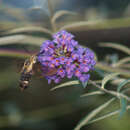pt-BR
nomes no trilho de navegação


Hummingbird moths are also known as white-lined sphinx moths. When the caterpillars are threatened they assume a position that resembles the Sphinx monument of Egypt. However, since they resemble hummingbirds, they are more commonly known as hummingbird moths. The sound of their beating wings is like that of hummingbirds. (Holzberg, 1999)
There is very little published about this species. Hummingbird moths are not readily studied and many things about them, such as their reproductive habits and behavioral patterns, are yet to be fully understood.
This species is not currently considered threatened on the state, federal, or global level.
US Federal List: no special status
CITES: no special status
State of Michigan List: no special status
Larvae of the closely related sphinx moth, called hornworms, are pests to tobacco and tomato plants as they oftentimes feed on them.
Hummingbird moths have little or no economic importance to humans. They are pollinators of some flowers, including the dune primrose. (Nicholson, 1999)
Hummingbird moths have a proboscis used to suck nectar from flowers. They feed from a variety of flowers, including honeysuckle, beebalm, lilac, snowberry and cranberry. They hover above the flowers and are often mistaken for hummingbirds. Their caterpillars feed on a variety of hosts, including honeysuckle, snowberry, hawthorns, cherries and plums. (Nicholson, 1999)
Hemaris thysbe may be found as far north as Alaska and the Northwest Territories. In the continental United States, Hemaris thysbe they occur west to Oregon. They are most common in the eastern part of the United States, and as far south as Florida and Texas. (Lawrence, 1999)
Biogeographic Regions: nearctic (Native )
The most common habitats for Hemaris thysbe include cultivated flower gardens, meadows, and forest edges. Hummingbird moths can fly long distances and are migratory. Only a few are able to cross desert regions because the scarcity of food and water. Their flight period is from May to September. (Holzberg, 1999)
Terrestrial Biomes: forest
The average wing span of hummingbird moths range from 4 to 5.5 cm. In adults, the wings are initially dark red to almost black. After their first flight however, some of the scales fall off, leaving clear spots with no scales. Thus, the wings are typically clear with a reddish to brown color border. The forewing cell has a medial row of scales and a dark margin. The body is spindle shaped and varies in color from olive green to reddish-brown. These moths lack the tympana possessed by most other moths. Their antennae are thickened from the base outward, usually to the middle only, and curved at the end. The larva are yellowish-green with darker green lines and reddish brown to dark brown.
(Struttmann, 1999)
Average mass: 3 g.
Other Physical Features: ectothermic ; bilateral symmetry
During winter, the larvae burrow in the soil and overwinter as hard-shelled, brown pupae. In May or June, hummingbird moths emerge from the pupae. They then deposit spherical green eggs on the undersides of leaves (usually of host plants). A week later, the larvae hatch and feed on fruit and leaves. Four weeks later, they are fully developed. Pupation occurs in the soil, and adults emerge 2 to 4 weeks later to lay a second generation of eggs. (Lawrence, 1999)